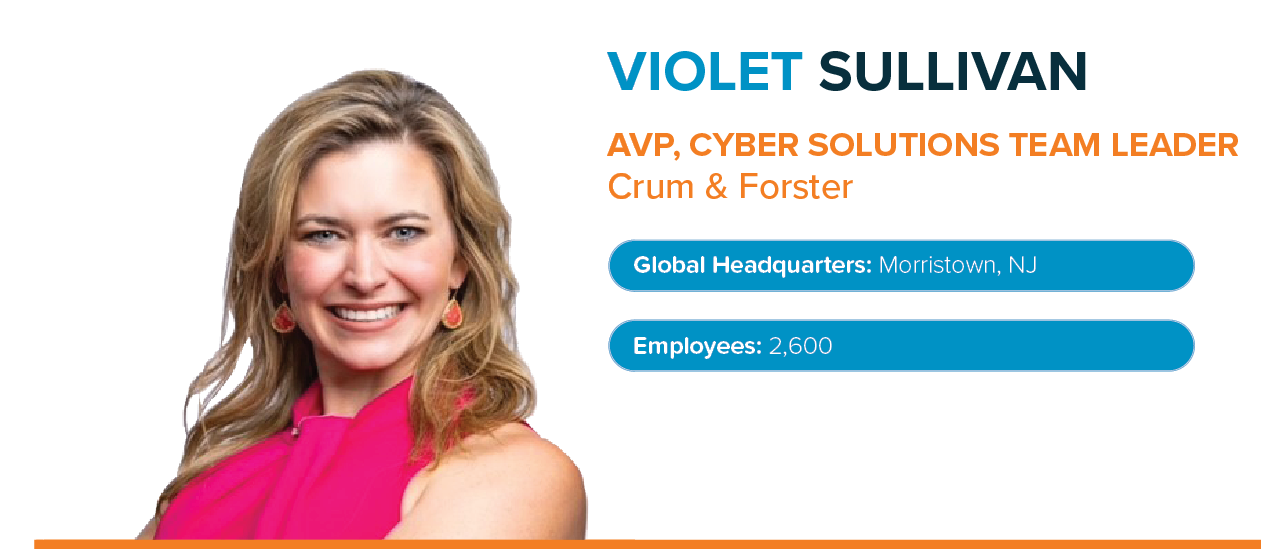
Violet was featured in the June 2025 Feats of Strength Magazine. View the PDF here.
The Calm in the Cyberstorm
Violet Sullivan is currently the Associate Vice President, Cyber Solutions Team Leader at Crum & Forster. She says, “My job is to be the calm in the chaos. I’m the person that brings a little bit of structure and maybe even a little bit of levity when it’s a very stressful time for a company.”
That unique ability to lead with clarity during cyber incidents where seconds matter and stress runs high has made her a trusted partner across all cyber response needs. Whether working alongside internal teams or clients navigating a breach, Violet thrives on creating confidence where there’s often confusion. “There’s something really rewarding about being in the trenches with people when they’re having their worst day,” she says. “And being the person who says, ‘Hey, we’ve got this.’ That’s why I love what I do.”
Translating and Communicating Effectively
Today, Violet wears many hats. “I’m a licensed attorney. I have my MBA. I teach at a law school. I speak at national conferences and am very active in the thought leadership space around cyber preparedness,” she explains. Her versatility allows her to operate in technical, legal, and executive circles, often acting as the translator between them.
“If I’m on a call with a bunch of engineers, I’m not going to give them a legal memo. If I’m on a call with the GC, I’m not giving them the technical jargon,” she says. “I’m the translator.”
Cyber Simulations: Training for the Worst Day
Violet is passionate about proactive preparation, especially breach simulations and tabletop exercises. “When it comes to simulations, that’s where I shine,” she says. “I love being in front of people and making them squirm just a little bit so that we can have a moment of realization, ‘this is not our strongest area’, and then build confidence.”
Her approach is rooted in the belief that crisis performance isn’t innate, it’s practiced. “We all think we’re going to rise to the occasion,” she explains, “but in a crisis, you fall to your level of training. So, if you’ve never practiced a breach response, if you’ve never sat in that seat, if you’ve never led the call, you’re not going to just miraculously be great at it.”
In those exercises, she focuses on human readiness, not just technical responses. “Cybersecurity is not a technical issue,” she says. “It’s a leadership issue. It’s a communication issue. It’s a process issue.”
Empowerment, Not Fear
Violet’s work centers on empowering teams with confidence, not burdening them with anxiety. “It’s not about scaring people. I want to empower people,” she says. “I want them to feel like, ‘Yeah, I can handle this. I’ve seen it before. I’ve practiced it.’”
Her ability to lead with empathy is a signature strength. “I like people. I’m a communicator more than anything else. I just happen to have legal and technical experience,” she says. It’s this human-centered mindset that makes Violet a trusted advisor before, during, and after a cyber crisis.
The Evolving Role of AI in Cybersecurity
Among the most exciting, and complicated, areas Violet is watching closely is artificial intelligence. “Everybody’s trying to figure out what AI means and what it’s going to do,” she says. “But it’s a little bit like ChatGPT, right? It’s only as good as the questions that you ask.”
She sees immense potential in AI but is also grounded in its limitations. “You have to know how to ask the right questions and what to do with the answers,” she explains. “That’s how I view AI in general. It’s going to be great, but it still needs humans to use it well.”
AI also poses new challenges in how teams prepare for and respond to threats. “We’re going to have to be careful,” she says. “AI will make some things better, and some things worse. We just have to train people to be smart and curious and thoughtful about how we use it.”
Her focus is less on replacing human insight and more on enhancing it. “You can’t automate good leadership,” she notes. “And you can’t outsource accountability in a crisis.”
Inside Crum & Forster’s Approach to Risk
At Crum & Forster, Violet plays a key role not only in response but also in strategic preparedness. “I work closely with breach response vendors, underwriting teams, and claims counsel to identify and onboard partnerships, evaluate vendor performance, and refine internal incident response procedures,” she says. Her work touches everything from policyholder support to internal simulation programs.
On the insurance side, she sees how companies often underestimate their exposure. “Sometimes we might offer free loss mitigation or preventative pre-breach services,” she explains, “but they treat it like insurance. It’s just there if something bad happens.” That mentality, she argues, is risky. “If people are only thinking about insurance in terms of financial coverage, they’re missing the point. It should also be about support, response, and readiness.”
Leadership in the Face of Uncertainty
For Violet, effective crisis leadership starts well before the incident. “You have to practice being decisive,” she says. “You have to practice being calm. That’s why I push these exercises so hard. You’re not going to just magically lead well if you’ve never been tested.”
Her philosophy is simple but powerful: be ready, be human, and be adaptable. Whether facing down a sophisticated ransomware attack or navigating the complexities of emerging AI threats, Violet returns to her core purpose. “My job,” she says, “is to be the calm in the chaos.”